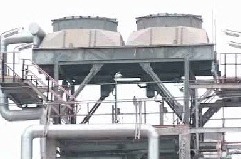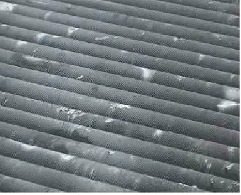Fin Tube Heat Exchanger Inspection
The Fin Tube Heat Exchanger Inspection article provides you with information about air-cooled heat exchanger inspection and testing in the manufacturing shop, as well as in operational plants. You may want to review fin tube heat exchanger inspection procedure and inspection and test plan.
The content covers the shop inspection during the manufacturing process, and the in-service Inspection in the operational plants.
The Air cooler inspection and testing is addressed in I4I Academy API 510 Pressure Vessel Inspector Online Course.
What is the Fin Tube Heat Exchangers?

The air cooler is an exposed tube bundle unit and air is used as the cooling medium.
The fin type tubes are used for Double Pipe Coils as well as for Air Coolers.
In the air coolers, the tubes are located in a steel framework and air is circulated by a fan placed either above or below the tube bank.
When the fan is above the tube bank it is called a draft air cooler, and when it is below the tube bank, it is referred to as a forced draft air cooler.

For another kind of classification, there are 3 types of air coolers: a header box with a removable cover plate, a header box with a removable bonnet and a header box with a fixed plug sheet.
In the first and second one, you can access the tube sheet similar to the shell and tube heat exchangers.
In the third one, you can access the tube sheet only through plug holes.
The first and second types generally are used in a low pressure system, and plug header is used for high pressure systems.
What are Fin Tube Heat Exchanger Inspection requirements in a Construction Shop?
The construction code for air-cooled heat exchangers is API Standard 661, and it covers the minimum requirements for design, materials, fabrication, inspection, testing, and preparation for initial delivery.
The API Standard 661 refers you to ASME Code Section VIII for pressure components including header boxes, tubes, and tube joints.
Specifically, if your Air Cooler needs to be “U” stamped, either optionally by the purchaser's decision or it is mandatory by the local authority in the place of installation, it is necessary to be stated in the purchase order.
For more details about stamped pressure vessels and requirements, review the Pressure Vessel Certification article.
With the above explanation, your inspection and test plan (ITP) for air-cooled heat exchangers needs to meet the requirements of both API Standard 661 and ASME Code Section VIII.
for more details, review the following articles:
Third Party Inspection for Fin Tube Heat Exchanger
Inspection and Test Plan for Fin Tube Heat Exchanger
If you are not familiar with ITPs, click here to review the Inspection and Test plan (ITP) article, which explains about ITP and its connections with construction codes.
What are In-Service Inspection Requirements for Fin Tube Heat Exchanger Inspection?
The In-Service Inspection code for your air-cooled Heat exchangers is similar to other pressure vessel in API STD 510. The other API recommendation practices and codes also have to be used in conjunction with this Code.
Some of these Recommend Practices are API RP 572, API RP 577, and API RP 571. Also construction codes might be used such as ASME Code Section VIII, ASME Code Section IX and API STD 661.
For Repair, the requirements of API STD 510 or ASME-PCC-2 need to be met.

The title of ASME-PCC-2, that had the first edition published in 2006 is:
“Repair of Pressure Equipment and Piping”
Please note: if your air-cooled heat exchanger is “U” stamped and you need to do repair, you have to use a Repair Organization holding an “R” Stamp from the National Board Inspection Code.
The API 510 Pressure Vessel Inspectors are qualified to do Fin Tube Heat Exchanger Inspection.
What are the Important Items for the in Fin Tube Heat Exchanger Inspection during Shutdown:
These are only the important points or a summary of points for air cooled heat exchangers in-service inspections and should not be considered an inspection procedure.
The air cooled heat exchanger inspection procedure is a comprehensive document that needs to cover inspection methods to be employed, equipment and material to be used, qualification of inspection personnel involved and the sequence of the inspection activities at minimum.
You may use the following content as summary only of the points for the in-service inspection of air cooled heat exchangers.
Fin Tube Heat exchanger Inspection is categorized by the following items:
Header Box and connected components Inspection
- Marking representatives plugs that need to be opened in the shut down
- Neutralization of austenitic stainless steel header box, which contains H2S service, based on approved procedure by the corrosion engineer
- Sampling of the header box fouling and corrosion products and making a lab analysis and then interpretation by a corrosion engineer
- Thickness measurements of different parts of the header box such as the top plate, bottom plate, end plate and making a remaining life calculation
- Dye penetration test on the heard box thermocouples
- Visual Inspection of the plug sheet, and specifically, the plug holes gasket contact surface for any possible erosion and damage
- Welding inspection of the nozzle to flange and flange to header box welds for any possible cracking and corrosion
- Visual inspection of the inner surface of nozzles for any possible fouling and corrosion
- Painting inspection of the external surface of header box
- Inspection of nozzles' small bore connections for any possible deformation and corrosion
- Inspection of the frame, supports, plenum and earthling system
- Specific attention to the thermal expansion in the start-up process and opening the header box and steel structure connection joints during the start-up process
- Specific attention to the air cooler's transformation to the repair shop to avoid any possible damage to the tube bundle, specifically in the rolling area
- Specific attention for using new gaskets for plugs
Tube Bundle Inspection
- Visual inspection of the external surface of the fin tubes for any possible mechanical damage and deformation
- Sampling from the tubes fouling and corrosion product and making lab analysis
- Visual inspection for the tube's edge for any possible corrosion and erosion
- Controlling of water jetting or lancing cleaning process
- Controlling wire brushing process of inner tube edge and rolling area (preparation for ID measurement)
- Inside diameter measurement in tubes and tubes rolling areas
- Rate off and accordingly plugging the tubes so their OD reaches to the ID plus one thickness
- Retubing of the tube bundle if more than 10% of the tubes reach the above rejection limit
- Pulling out a sample tube for sectioning and corrosion analysis if necessary
- Hydro-static testing and inspection of tubes, header boxes and plugs.
2 Free CPD Hours Courses - Completely Free
Enroll, Watch the Video, Take the Test, Download Your Cert and Submit to the API . 2 free courses are availble each with 2 hours credit. (Total 4 hours) - 1) ASME V Articl II , 2) ASME V Article 6 & 7